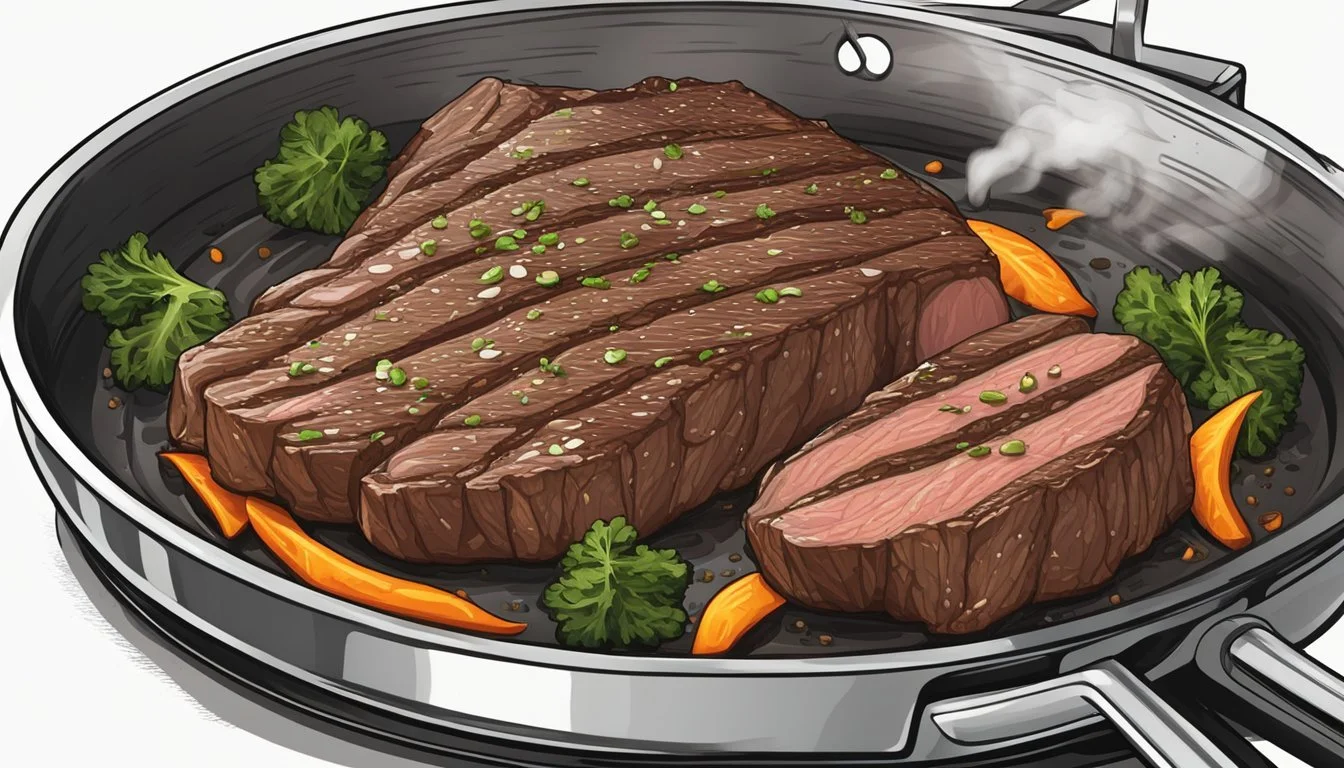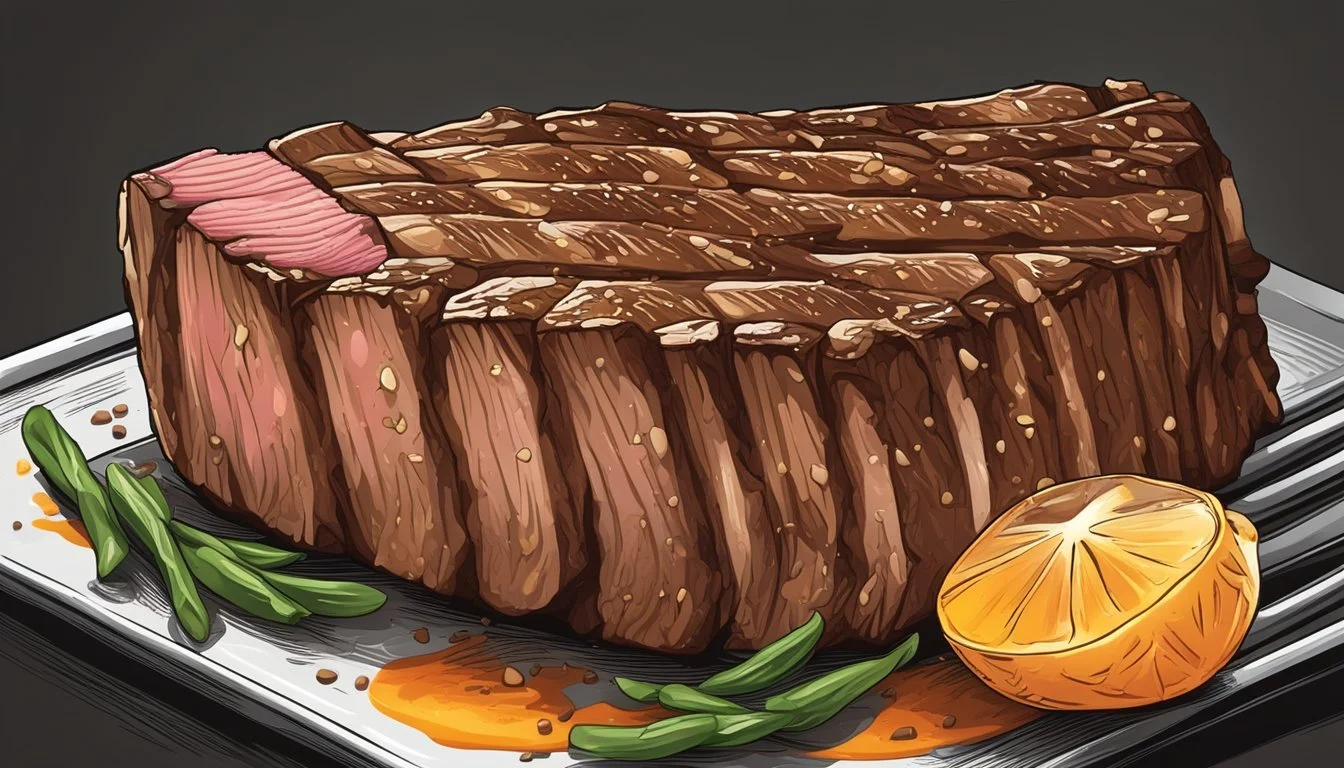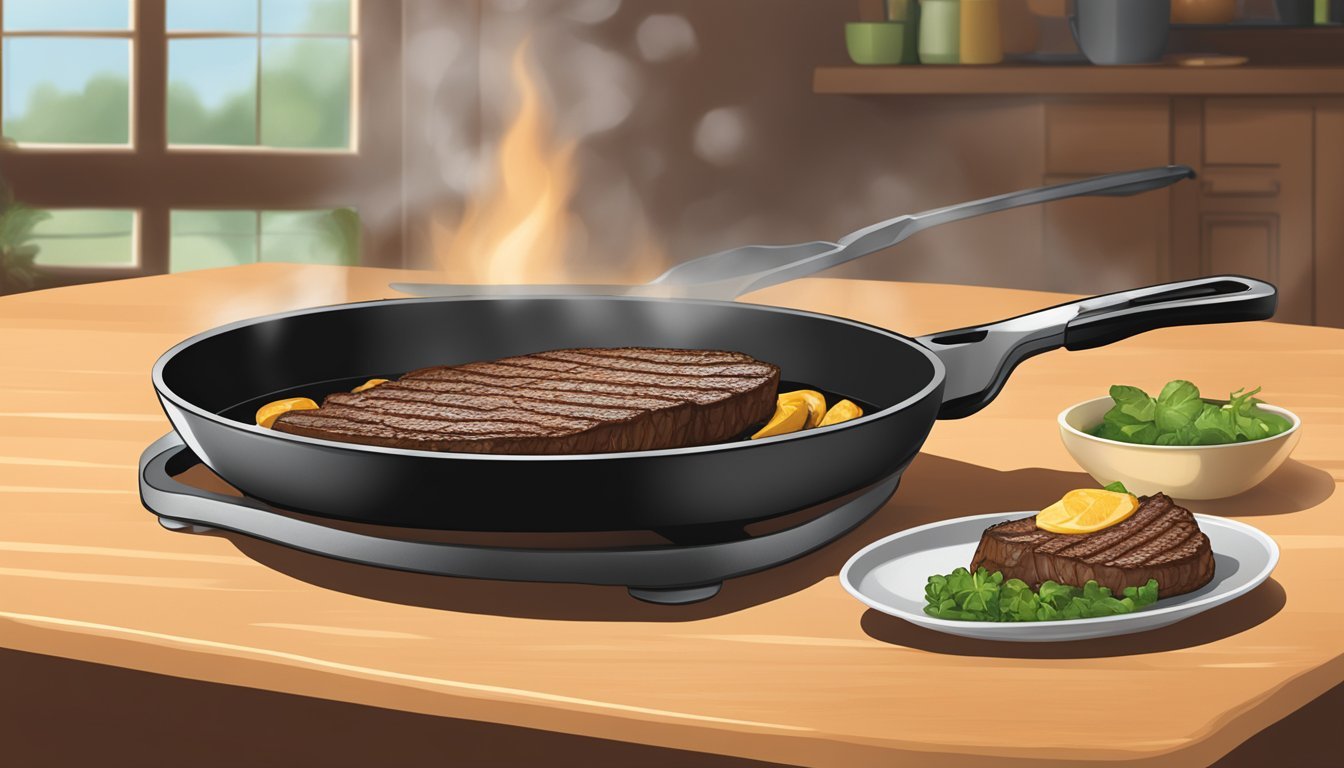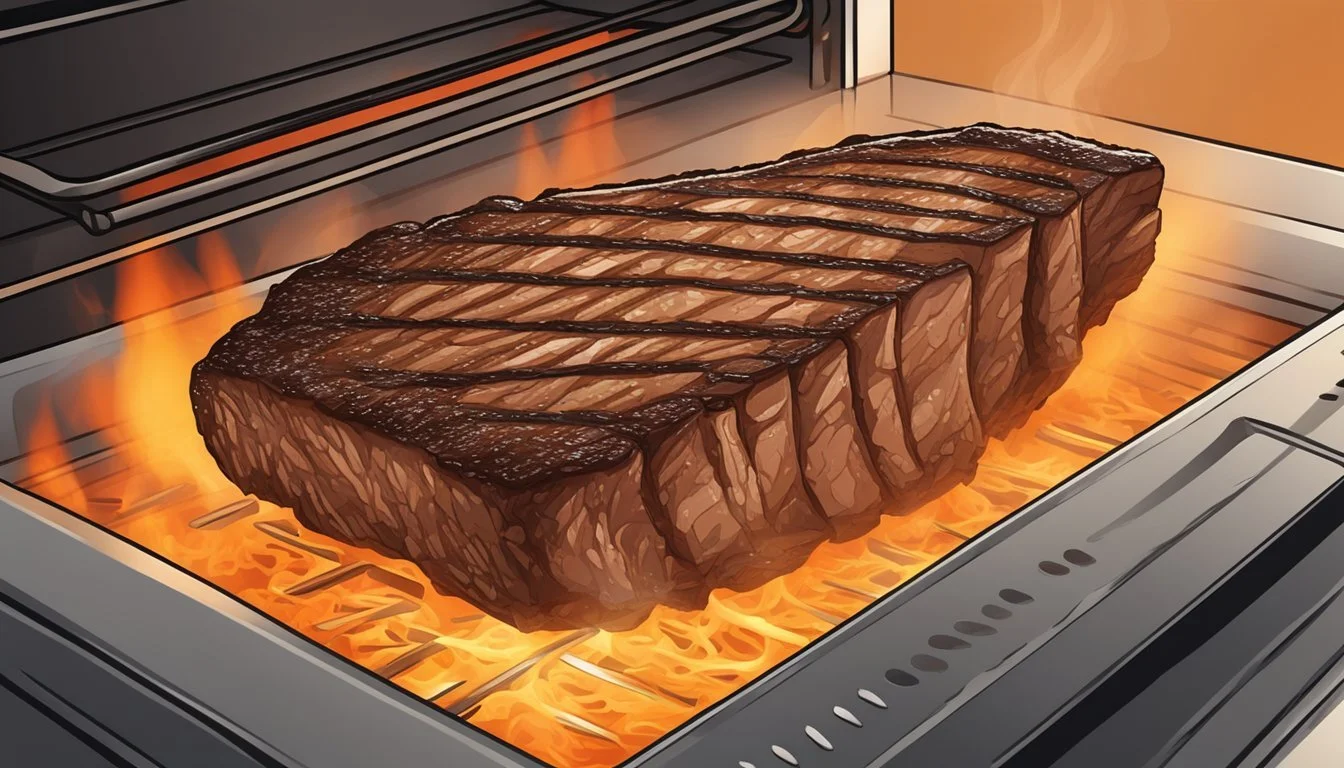Best Way to Reheat Tri-Tip Steak
Ensuring Maximum Juiciness and Flavor Retention
Tri-tip steak is a flavorful and tender cut of beef that has gained popularity for its rich taste and versatility in dishes. Reheating this delicacy, however, presents a challenge to many, as the goal is to maintain its juiciness and flavor that can be diminished through incorrect reheating methods. It's pivotal to approach the reheating process with techniques that cater to preserving the meat's moisture and the savory crust developed during its initial cooking.
The best way to reheat tri-tip steak involves gentle heating methods that warm the meat without overcooking it. An oven, set at a low temperature, is often recommended to achieve an even warmth that doesn't sap the steak of its natural juices. Placing the tri-tip on a roasting rack over a pan of water creates a humid environment in the oven, assisting in keeping the meat succulent during the reheating process. A slow cooker can also be utilized for reheating, especially if the goal is to infuse the tri-tip with additional moisture from a broth, sauce, or gravy. This approach allows the steak to reach the desired temperature gradually, ensuring that it remains tender and flavorful.
Understanding Tri-Tip Steak
Tri-tip steak is a cut of beef that has risen in popularity due to its flavor and versatility. Originating from the bottom sirloin subprimal cut, it is known for its triangular shape and is sometimes referred to as a tri-tip roast when sold as a whole piece.
Characteristics of Tri-Tip:
Shape: Triangular
Location: Bottom sirloin
Texture: Lean with some marbling
Flavor: Rich and beefy
Tri-tip is often celebrated for its balance between tenderness and flavor, making it a favored option for grilling, smoking, and roasting. Though not as tender as cuts like filet mignon, it offers a pleasing texture when cooked properly.
Because of its size, usually ranging from 1.5 to 2.5 pounds, tri-tip is an excellent choice for family meals or gatherings, providing enough servings without the excess of larger roasts.
When dealing with leftover tri-tip, maintaining the meat's succulence during reheating is paramount. The goal is to preserve the juiciness that made the original meal enjoyable.
From a cost perspective, tri-tip is viewed as an inexpensive alternative to pricier cuts while still delivering a depth of flavor that appeals to beef enthusiasts. It serves as a testament to the idea that delectable meals do not always have to come at a high price.
In summary, tri-tip's appeal lies in its robust flavor, relative tenderness, and cost-effectiveness, making it a smart option for various culinary applications.
Storing Leftover Tri-Tip for Optimal Freshness
Proper storage is critical for maintaining the freshness and flavor of leftover tri-tip. By following specific refrigeration and freezing guidelines, the integrity of the meat can be preserved for future enjoyment.
Refrigerating Leftovers
Time Frame: Leftover tri-tip should be refrigerated within two hours of cooking to prevent bacterial growth.
Container: Place the tri-tip in an airtight container or wrap it securely with aluminum foil or plastic wrap.
Temperature: Keep the refrigerator temperature at or below 40°F (4°C) to ensure the steak remains safe to consume.
Duration: Refrigerated tri-tip is best used within 3 to 4 days for optimal flavor and safety.
Freezing Tips
Preparation: Prior to freezing, slice the tri-tip into smaller portions if desired. This will make thawing and reheating more manageable.
Wrapping: Wrap the pieces tightly in freezer paper, plastic wrap, or aluminum foil to prevent freezer burn. For enhanced protection, place the wrapped meat inside a freezer bag.
Vacuum Sealer: If available, use a vacuum sealer to remove air from the packaging, which helps in preserving the meat's quality for a longer period.
Labeling: Label the freezer bag or wrap with the current date to keep track of how long the tri-tip has been stored.
Duration: Properly stored frozen tri-tip can last up to 6-12 months in the freezer while maintaining its best quality.
Precautions to Prevent Food Poisoning
When reheating tri-tip steak or any leftovers, individuals must be cautious to avoid food poisoning. They should ensure that the steak is stored properly before reheating. It's important to keep the meat at a safe temperature, so it doesn't become a breeding ground for bacteria.
Proper Storage: Any uneaten tri-tip should be stored in a sealed container and placed in the refrigerator within two hours of cooking. This helps maintain the steak below the danger zone temperature of 40°F to 140°F, where bacteria can thrive.
Reheating Safely: When reheating, one must bring the tri-tip to an internal temperature of at least 165°F for safety as per USDA recommendations. Using a meat thermometer is the best way to ensure the correct temperature is reached.
Cross-Contamination: Avoid using the same surfaces or utensils for cooked and raw meat without proper cleaning. This prevents cross-contamination, one of the common causes of food poisoning.
Here is a quick checklist for safe reheating:
Store leftover tri-tip in a refrigerated environment (at or below 40°F).
Use a secure container with a tight seal to prevent air and bacteria from entering.
Reheat to an internal temperature of 165°F, as recommended.
Prevent cross-contamination by using clean utensils and surfaces for handling reheated meat.
By following these guidelines with confidence, one can reduce the risk of food poisoning and enjoy their flavorful tri-tip steak safely.
Reheating Tri-Tip in the Oven
Reheating tri-tip in an oven can produce a steak that is warm throughout and retains its juicy flavor if done correctly. This process involves preparing the meat and oven then utilizing specific techniques to ensure even reheating.
Preparing the Oven and Steak
One begins by setting the oven temperature to moderate heat, typically 250°F (120°C), which facilitates gentle warming. The steak should be removed from the refrigerator allowing it to reach room temperature, which approximately takes 20 minutes. This step is crucial for even reheating throughout the meat.
Prepare the Oven: Preheat the oven to 250°F.
Steak at Room Temperature: Let the tri-tip sit outside the fridge for about 20 minutes.
Oven Method Techniques
For the oven method, one should employ indirect heat to reheat the steak. This is accomplished by placing a roasting rack in a baking pan, and then filling the pan with a small amount of water to create a humid environment that helps prevent the steak from drying out.
Indirect Heat: Set up a roasting rack above a baking pan with water to provide moisture.
Covering the Steak: Wrap the tri-tip in aluminum foil to lock in juices and enhance flavor preservation.
Reheating Time: Place the tri-tip in the oven and reheat for approximately 20-30 minutes. Use a food thermometer to check the internal temperature reaches 165°F, ensuring it's safe to eat.
By following these steps, one can achieve a juicy and flavorful reheated tri-tip steak.
Using the Sous Vide Technique
Reheating tri-tip steak through the sous vide method involves precise temperature control to ensure that the steak retains its moisture and flavor. By using a water bath, the steak is heated evenly without the risk of overcooking.
Sous Vide Setup
To begin reheating tri-tip using the sous vide method, one needs to preheat a sous vide machine to a specific temperature. The goal is to achieve a temperature that warms the meat without cooking it further, typically around 130°F to 140°F for medium-rare. The tri-tip should be placed inside a vacuum-seal bag, ensuring that all air is removed before sealing. This process not only helps in even reheating but also preserves the meat's juices and flavor.
The Water Bath Process
Once the sous vide machine reaches the desired temperature, the vacuum-sealed tri-tip is submerged in the water bath. It is crucial that water completely surrounds the bag to facilitate consistent heating. The tri-tip should remain in the water bath until it is thoroughly heated, which usually takes about 45 minutes to an hour, depending on the steak's thickness. It is important to ensure that the temperature of the water does not fluctuate, as the sous vide reheating process relies on stable heat to warm the tri-tip gently and evenly.
Skillet Reheating for a Crisp Exterior
When reheating tri-tip steak on a skillet, one can achieve a deliciously crisp exterior without compromising the cut's inherent tenderness and juiciness. The approach requires careful heat management and proper preparation to ensure the meat remains succulent.
Skillet Heating Tips
Reheating tri-tip in a skillet is an effective method to restore the desirable crust that might have been lost during refrigeration. To begin, one should allow the steak to reach room temperature, which typically takes about 30 minutes on the countertop. This step is crucial for even heating. Then, one should heat the skillet over medium-high heat on the stovetop before adding the steak.
Heat Settings:
Medium-high heat: This is the optimal starting temperature to achieve a good sear without burning the steak.
Time: The tri-tip should be heated for several minutes on each side, typically no more than 2-3 minutes per side, depending on the original level of doneness.
Skillet Reheating Timeline:
Action Time Heat Skillet 2-3 minutes (or until adequately hot) Add Tri-Tip Sear for 2-3 minutes on first side Flip Sear for additional 2 minutes Check for Warmth If necessary, heat through for 1-2 minutes
The tri-tip should be moved frequently to prevent burning and ensure an even sear. Tongs are a preferable utensil for moving and flipping the meat, as they provide greater control and reduce the likelihood of puncturing the meat, which can cause loss of juices.
Maintaining Moisture and Juiciness
To keep the tri-tip tender and juicy during skillet reheating, one should consider employing techniques that retain the steak's moisture. One such method is lightly brushing the steak with its own juices or an appropriate marinade before searing. This not only helps maintain moisture but also adds a layer of flavor.
During the reheating process, one should avoid overcooking the meat, as excessive time on the skillet can cause it to dry out. It's critical not to press down on the steak, as this action can squeeze out valuable juices that are essential for keeping the meat succulent.
Moisture Retention Strategies for Skillet Reheating:
Preheat the Skillet: A hot skillet promotes rapid searing and less cooking time.
Room Temperature Meat: Ensures even heating and protection of interior moisture.
Marinade or Juices: Brushing the meat can replenish surface moisture and enhance flavor.
Manage Time: Minimize skillet time to avoid drying out the steak.
Do Not Press: Pressing the steak can lead to loss of juices and result in a less juicy outcome.
The skillet reheating method is revered for its ability to replicate the texture and flavor of freshly cooked tri-tip, granting the steak a rejuvenated exterior while maintaining the moisture within. With these tips, the skillet can become an invaluable tool for reheating, delivering a balance of a crisp crust and a succulent interior.
Grill-Based Reheating Methods
Reheating tri-tip on the grill can preserve its smoky flavor and ensure the meat remains juicy. Utilizing indirect heat is key to achieving optimal results.
The Grilling Approach
To reheat tri-tip steak effectively on a grill, one should first preheat the grill to a moderate temperature. The ideal setup involves lighting the fire on one side of the grill to create a hot zone and an indirect heat zone. Indirect heat is crucial, as it warms the meat gently and prevents overcooking.
Reheating on the Grill
When reheating a smoked tri-tip on the grill, the steak should be placed on the side of the grill without the direct flame (the indirect heat zone). It's recommended to:
Wrap the tri-tip in aluminum foil to retain its juices and flavor,
Set the meat off the flame,
Monitor the internal temperature, aiming for a warmth that suits the diner's preference, typically taking 4-7 minutes.
One should let the tri-tip rest for a few minutes after reheating before serving, to allow the juices to redistribute. This method keeps the meat tender and flavorful.
Air Fryer Reheating for Speed and Convenience
Reheating tri-tip steak in an air fryer offers both speed and ease, making it an efficient method for those seeking a quick meal without compromising on taste.
When utilizing an air fryer method, one must initially ensure it's preheated to a medium temperature. The ideal temperature setting is usually around 360°F, as higher temperatures may risk overcooking the steak's exterior before the inside is sufficiently warmed.
The process begins with removing the tri-tip from the refrigerator and allowing it to reach a near-room temperature. This step helps in achieving even reheating. Once tempered and pat dry, the steak should be placed in the air fryer basket without overcrowding, with sufficient space around it to promote even airflow.
Reheating should be monitored closely. Usually, a period of 3 to 5 minutes suffices, but this can vary based on the thickness of the steak and the individual air fryer's efficiency. It's advisable to flip the steak halfway through the reheating cycle to ensure uniform warmth.
Here's a concise breakdown of the air fryer method for reheating tri-tip steak:
Preheat air fryer to 360°F.
Let the tri-tip steak acclimatize to room temperature.
Place the steak in the air fryer basket, avoid overlapping.
Reheat for 3–5 minutes, flipping halfway through.
Check for desired warmth; continue heating in short intervals if necessary.
Using an air fryer for reheating tri-tip steak is a balance of maintaining juiciness while also achieving a desirable serving temperature quickly. It stands out as a prime option for those valuing their time and wishing to enjoy a flavorful steak that retains much of its original texture and taste.
Microwave Reheating: Fast But Tricky
When reheating tri-tip steak in a microwave, the main challenges are avoiding overheating and ensuring the meat remains moist. These steps can maintain the steak's juiciness and flavor with speed and efficiency.
Avoiding Overheating
Start by reheating in short intervals: Use a microwave-safe plate and heat the tri-tip in 30-second bursts.
Check the steak frequently: Between intervals, touch the steak to assess its warmth. This prevents overcooking.
Flip the steak: After each interval, flip the steak to promote even heating throughout the meat.
_Creating Moisture_
Damp Paper Towel Method: Cover the tri-tip with a damp paper towel to provide moisture and prevent drying out.
Wet Bread Bed: An alternative is placing a piece of wet bread beneath the tri-tip on the plate, creating a humidity chamber effect within the microwave.
Using these methods, one can achieve a satisfactorily reheated tri-tip in the microwave without sacrificing its juiciness or flavor.
Alternative Reheating Methods
Reheating tri-tip steak while retaining its moisture and flavor can be accomplished through a variety of methods that go beyond the conventional oven or microwave. This section will delve into the specifics of using a crock pot and steaming/broiling techniques as alternative reheating methods.
Crock Pot and Slow Cooker
For those who prefer a more hands-off approach, a crock pot or slow cooker offers an excellent alternative. To reheat leftover tri-tip in a slow cooker:
Place the tri-tip inside the crock pot.
Add a small amount of broth or water to maintain moisture.
Cover with the lid and set the slow cooker to a low heat setting.
Heat the tri-tip until it reaches the desired temperature, which typically takes about 1-2 hours.
This process ensures the meat remains tender and juicy.
Steaming and Broiling Techniques
Using steaming and broiling techniques can also reheated tri-tip efficiently. Here's how:
Steaming Method:
Place leftover tri-tip in a steamer basket.
Ensure there is water in the bottom of the pot for steam generation.
Cover and heat on a medium flame, allowing the steam to warm the tri-tip through.
Broiling Method:
Preheat the broiler.
Place tri-tip on a broiler pan.
Position the pan so the meat is a few inches away from the heat source.
Broil for several minutes on each side, checking frequently to avoid overcooking.
Both methods help to preserve the steak's inherent flavors while bringing it back to ideal serving temperature.
Serving Recommendations and Final Touches
When serving reheated tri-tip steak, one must ensure it remains as juicy and flavorful as its initial cooking. For enhancing tenderness and ensuring the meat doesn't dry out, consider serving it with a complementary gravy or sauce. A simple au jus can be prepared by collecting the reserved juices from the reheating process, adding them to a saucepan, and bringing them to a gentle simmer. One can thicken the juices with a roux or cornstarch slurry for a richer gravy.
Sliced Tri-Tip Accompaniments:
Gravy: Enhance with herbs to match your dry rub.
Broth: Deglaze the reheating pan with beef broth for extra depth.
In addition to sauces, one may want to offer side dishes that balance the meal. Vegetables roasted in the same oven during reheating or a light salad can complement the rich flavors of the tri-tip.
Sidelines for the Main Course:
Roasted Vegetables: Tossed in olive oil and seasoned to taste.
Fresh Salad: With a vinaigrette to cut through the meat’s richness.
For the final touches, if the surface of the leftover tri-tip isn't as crisp as desired, a brief sear in a hot skillet can reinvigorate the crust. Just a minute on each side over high heat should suffice without overcooking the interior.
Sealing in the Juices:
Heat skillet over high heat.
Sear the tri-tip for 1 minute each side.
By implementing these serving recommendations and final touches, one can confidently present a dish that upholds the succulence and satisfying flavors of a freshly cooked tri-tip steak.
Food Safety and Temperature Guidelines
When reheating tri-tip steak, food safety is paramount to prevent food poisoning. It is crucial to ensure that the steak reaches an internal temperature high enough to eliminate any potential bacteria. The United States Department of Agriculture (USDA) recommends that reheated steaks achieve an internal temperature of 165°F to ensure safety.
Temperature Measurement:
A food thermometer or a meat thermometer is necessary to check the temperature.
An instant-read thermometer can provide a quick and accurate reading.
Correct Usage of Thermometers:
Place the thermometer in the thickest part of the tri-tip to check the temperature.
Avoid touching bone or fat for an accurate measure.
When reheating:
Heat evenly to avoid cold spots, which can harbor bacteria.
If using an oven, preheat to 250°F and place the tri-tip on a roasting rack, using a baking pan with water below to retain moisture.
In a microwave, heat the tri-tip in 30-second intervals, flipping it for even warming.
Guidelines for Safe Reheating:
Oven: Preheat to 250°F. Reheat tri-tip until internal temperature reaches 165°F.
Microwave: Cover with a damp paper towel. Heat in 30-second intervals to an internal temperature of 165°F.
Slow Cooker: Use low setting to warm. Maintain temperature at 165°F for safety.
Always allow the meat to rest for a few minutes after reheating. This ensures that the juices redistribute and the internal temperature remains consistent throughout the steak, further ensuring each slice is free from harmful bacteria.





